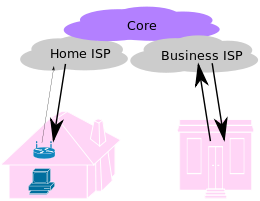Downstream (networking)

In a telecommunications network or computer network, downstream refers to data sent from a network service provider to a customer.[1]
Although the best dial-up modems are called 56 kbit/s modems, downstream speeds can be limited to a few tens of kilobits per second with even lower upstream speeds. Asymmetric digital subscriber line (ADSL) and cable modems, two popular Internet access technologies, greatly improved downstream speeds reaching several Mbit/s. Mobile broadband and satellite Internet access providers also often have lower upstream speeds than downstream.
One process sending data primarily in the downstream direction is downloading. However, the overall download speed depends on the downstream speed of the user, the upstream speed of the server, and the network between them.
In the client–server model, downstream can refer to the direction from the server to the client.
References
- ^ Broadband Services, Applications, and Networks: Enabling Technologies and Business Models. International Engineering Consortium. p. 130. ISBN 978-1-931695-24-4.
